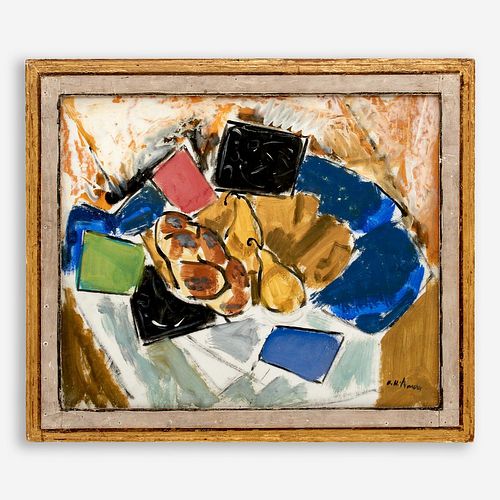ALFRED MAURER "Still Life" (1920s Oil)
Bid Increments
| Price | Bid Increment |
|---|---|
| $0 | $25 |
| $500 | $50 |
| $1,000 | $100 |
| $5,000 | $250 |
| $10,000 | $500 |
| $20,000 | $1,000 |
| $50,000 | $2,500 |
| $75,000 | $5,000 |
| $100,000 | $10,000 |
(New York, 1868-1932)
Still Life, circa 1920s
Oil on board
18" x 21 1/2"
Signed "A.H. Maurer" to the bottom right. The reverse of the frame has a window displaying the tag of Erhard Weyhe, a New York dealer who represented Maurer beginning in 1924 and arranged annual exhibitions for Maurer until 1931. The glazed frame measures 22" x 25 1/2" x 1 1/4".
Alfred Maurer has been described as "the first American Modernist painter," with his style evolving from Tonalism to Fauvism to Cubism. The son of a commercial lithographer, Maurer studied with William Merritt Chase and John Quincy Adams Ward before moving to Paris in 1897 to attend the Acadamie Julien. There in the heart of the modern art world, Maurer's artistic talent and style fourished and developed, and he created friendships with Gertrude and Leo Stein, Paul Cezanne, and Henri Matisse. He participated in significant modern exhibitions including the 1907 Salon d'Automne and Armory Show of 1913.
This period in his career was abruptly interrupted with the onset of World War I, sending him back to New York, where the American market for modern art had hardly begun. With the hurried repatriation, Maurer lost most of his work; he suddenly found himself critically ignored and thrust into an acutely stressful relationship living with his father, who disdained modern art. Nevertheless, Maurer helped pave the development of American Cubism throughout the 1920s, with colorful abstract compositions of figures and of still life (this painting being from that period). Tragically, his personal and professional frustrations culminated when his father passed away, and he took his own life soon after in 1932. His career and work, though appreciated by his peers, was largely ignored by the American market and critics until later reappraisal.
Condition
Pick Up, Packing, & Shipping: Winning bidders may pick up their lots, once paid in full, at Circle’s auction office during regular business hours. If packing and shipping is required, we can provide you with a list of recommended shippers by request. You will be responsible to contact, arrange shipment, and pay 3rd party shippers. Circle will not be responsible for loss or damage of purchased lots handled or shipped, nor for acts and omissions, by 3rd party shippers, whether recommended by us or not. Circle will not release the lot for shipment until payment has been made in full and a buyer’s written shipping authorization form has been received. Winning bids may not be retracted, canceled or rescinded due to issues with shipping including, but not limited to, costs or prohibitions. It is the responsibility of the bidder to account for shipping prior to bidding. Failure to Pick Up & Storage: Winning bidders must pick up or have lots shipped within 15 calendar days of the close of the auction. On the 16th day from the close of the auction Circle has the right to charge the winning bidder a storage fee of $5 per lot per day. Lots that have been paid for, but remain on our premises sixty (60) days from the close of the auction may be sold by Circle, with no notice to the buyer. Any funds in excess of the purchase price, commissions, applicable costs, and storage fees will be remitted to the original winning bidder. At the point where storage fees associated with an unshipped item exceed the hammer price of the item the winning bidder will be considered in default of our terms and conditions and forfeits ownership to Circle Auction or its affiliated companies. In the case where the item is forfeited the winning bidder will not be compensated in any way. Lots left with Circle after the 16th day from the close of the auction are stored at the buyer’s risk. If you have any questions regarding these terms please contact Circle Auction by email at : Info@Circle-Auction.com










